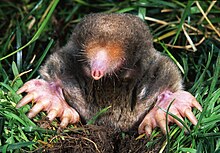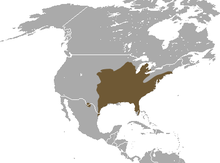Eastern mole
| Eastern mole[1] | |
|---|---|

| |
| Scientific classification | |
| Domain: | Eukaryota |
| Kingdom: | Animalia |
| Phylum: | Chordata |
| Class: | Mammalia |
| Order: | Eulipotyphla |
| Family: | Talpidae |
| Genus: | Scalopus É. Geoffroy,1803 |
| Species: | S. aquaticus
|
| Binomial name | |
| Scalopus aquaticus | |

| |
| Eastern mole range | |
| Synonyms | |


Theeastern moleorcommon mole(Scalopus aquaticus) is a medium-sizedNorth Americanmole.It is theonly speciesin thegenusScalopus.It is found in forested and open areas with moist sandysoilsin northernMexico,theeasternUnited Statesand the southwestern corner ofOntarioinCanada.
The eastern mole has grey-brown fur with silver-grey underparts, a pointed nose and a short tail. It is about 16 centimetres (6.3 in) in length including a 3 centimetres (1.2 in) long tail and weighs about 75 grams (2.6 oz). Its front paws are broad and spade-shaped, specialized for digging. It has 36 teeth. Its eyes are covered by fur and its ears are not visible.
The eastern mole spends most of its time underground,foragingin shallowburrowsforearthworms,grubs,beetles,insect larvae and some plant matter. It is active year-round. It is mainly solitary except during mating in early spring. The female has a litter of two to five young in a deep burrow.
Subspecies
[edit]A majority of the moles throughout their range areScalopus aquaticus aquaticus.All the other subspecies exist in small pocket ranges.
| Subspecies | Name | Range |
|---|---|---|
| S. a. aquaticus | Eastern mole | Throughout the mainland United States and Canada |
| S. a. anastasae | Anastasia Island mole | Anastasia Island,a small close-to-shore island off ofSt. Augustine, Florida.[4] |
| S. a. bassi | Englewood mole | The area within and surroundingEnglewood, Florida.[5] |
| S. a. texanus | Presidia mole | The Rio Grande near and between the Cibolo and Alamito Creeks.[6] |
See also
[edit]- Rockport virus
- Hantavirus pulmonary syndrome
- Mole (animal)for more general information on moles
References
[edit]- ^Hutterer, R. (2005).Wilson, D.E.;Reeder, D.M. (eds.).Mammal Species of the World: A Taxonomic and Geographic Reference(3rd ed.). Johns Hopkins University Press. pp. 301–302.ISBN978-0-8018-8221-0.OCLC62265494.
- ^Matson, J.; Woodman, N.; Castro-Arellano, I.; de Grammont, P.C. (2017) [errata version of 2016 assessment]."Scalopus aquaticus".IUCN Red List of Threatened Species.2016:e.T41471A115188304.doi:10.2305/IUCN.UK.2016-3.RLTS.T41471A22319923.en.Retrieved11 March2022.
- ^"Explore the Taxonomic Tree".
- ^"Anastasia Island Mole (Scalopus aquaticus anastasae) mEAMOa_CONUS_2001v1 Habitat Map - ScienceBase-Catalog".
- ^"Mammalogy 39436: Scalopus aquaticus bassi".
- ^"Presidio Mole (Scalopus aquaticus texanus) mEAMOt_CONUS_2001v1 Habitat Map - ScienceBase-Catalog".
External links
[edit] Media related toScalopus aquaticusat Wikimedia Commons
Media related toScalopus aquaticusat Wikimedia Commons Data related toScalopus aquaticusat Wikispecies
Data related toScalopus aquaticusat Wikispecies

